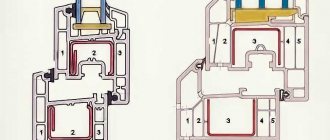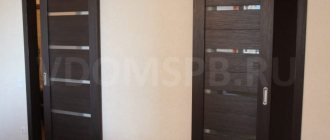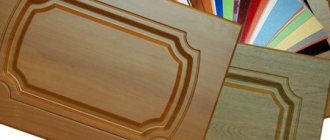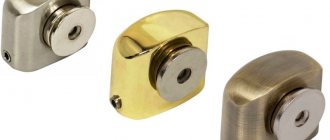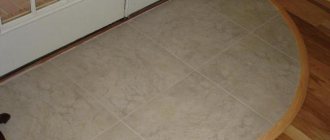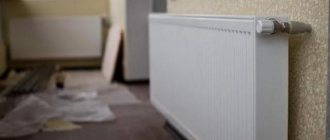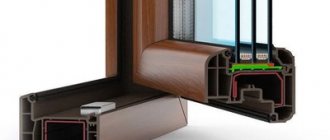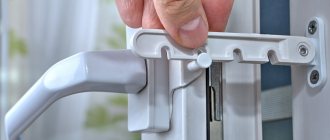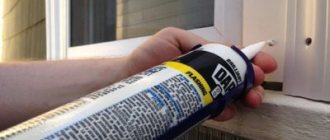What is each type of door finish?
The main task facing any production is to reduce the cost of products while maintaining quality. Since the manufacture of doors often uses materials different from the original ones (if previously they were made from solid wood, now this is rather considered a luxury), the standards themselves have changed. It is clear that there cannot be a clear solution, for example, which is better - PVC doors or veneer, each coating has its own characteristics. First, consider each material and its constituent elements.
Veneered doors
Externally, doors made of this material are closest to classic solid wood structures - these models have the same surface pattern, similar performance properties, but their cost is much lower. This is explained by structural features, because veneer is a thin slice of wood, 0.2 to 5 mm thick, and it is glued to the outer part of the door surface.
The interior is made either from solid wood of a less expensive type of wood, or from chipboard and MDF. Another option is a frame made of pine bars, the cavities in which are filled with cardboard honeycomb filler and sheathed with MDF sheets. This design has much less weight than solid wood models, but it is somewhat less durable.
The veneer layer is glued to the finished frame using vacuum hot pressing, which ensures the strength and durability of the fastening. For maximum preservation of appearance, finished doors are varnished - this emphasizes the grain of the wood and protects the veneer layer from ultraviolet radiation and mechanical influences.
As a result, veneered doors do not differ in appearance from those made from solid wood - to a non-professional, they will only be given away by the lower weight of the structure, but for interior models this is rather an advantage. Since such doors are made from various artificial materials, they are less sensitive to temperature changes, and the low cost compared to solid wood models makes this option one of the best purchasing solutions.
The general disadvantage of such door panels is inherent in all wooden models - without special treatment it is better not to install them in wet rooms. Also, it is better not to place veneered doors in a place where direct sunlight falls - despite the protective varnish, they can darken over time.
Laminated doors
This is one of the most economical options. Structurally, they consist of a wooden frame, lined with MDF panels, on which a laminated coating with the desired pattern or color is applied. The outside surface is covered with a protective layer. The internal cavities of the frame are filled with various fillers - mainly cardboard honeycombs, but chipboard and MDF can also be used.
The main advantage of such a door is its low cost and stable color - laminate manufacturing technology allows you to get the same color even in products from different batches.
The laminate is resistant to moisture, and the stacked door frame ensures no deformation due to temperature changes. Such models are lightweight, so they can be used for installation in any interior partitions.
Doors covered with eco-veneer
Eco-veneer is a film made of polyurethane foam with wood shavings. Ecopchon has found application in door production for a number of reasons. In particular, natural wood fibers glued together with polymers are used in its production. When applied to a flat surface, its relief becomes similar to wood, not only in appearance, but also to the touch.
Eco-veneer is called environmentally friendly for the reason that it is chemically inert and does not contain chlorides - this is one of the criteria that can be used when deciding which is better - PVC doors or eco-veneer. In any case, there is nothing in common between “eco” and natural veneer except the surface texture. Some sellers take advantage of the external similarity and present eco-veneer as “the same veneer, only better,” arguing that it is not afraid of moisture.
In fact, only the internal parts of the frame are identical, and the outer covering is made of different materials. This does not mean the poor quality of such a coating - quite the contrary - this is a new word in the manufacture of doors, it’s just that if for some reason you need a completely natural wooden covering, then ekopchon will not work in this case.
Doors covered with PVC film
Unlike classic plastic doors, which are made entirely of PVC profiles, these models have a traditional wooden frame, which is coated with polyvinyl chloride.
The film application technology involves the use of special chambers into which the frame of the door leaf coated with synthetic glue is placed. A film is applied on top of the surface, which is then baked at high temperature - a diffusion process occurs, as a result of which the PVC becomes part of the surface of the door. This technology allows you to obtain matte or shiny surfaces of any color and texture.
PVC film can be applied to a frame made of solid wood, which is made from a single piece of wood or beams glued together. In this case, the solid wood is taken from inexpensive, usually coniferous, wood species.
The second option is doors in which the frame is made of beams. The voids are filled with cardboard honeycomb filler, and the top is covered with MDF panels, onto which PVC film is applied.
When choosing between veneered, laminated, eco-veneer or PVC film-coated doors, you need to take into account a large number of factors. Which ones to pay attention to first, and which ones can be ignored, depends on where and by whom such doors will be used.
Subtleties of choice
If you have made a choice in favor of interior doors made of eco-veneer, and you are satisfied with the pros and cons, it’s time to decide on a specific model. I would advise choosing the product to match the interior style of your home. For convenience, all doors can be divided into three groups.
For a classic space, a blank, laconic door or a panel with frosted glass inserts is suitable. The modern style will be successfully complemented by a model with clear geometric shapes. There are also universal options in standard colors; they will fit into any space.
Textures for every taste Source plpstatic.ru
Color solutions
Manufacturers strive to reproduce the natural beauty of wood, so eco-veneer often imitates a variety of natural structures; models of unnatural shades are practically absent. When comparing eco-veneer or PVC, the advantage is on the side of polypropylene. Its structure has depth, which is revealed when the viewing angle changes.
It is easy to transfer any wood texture to the door leaf; options with a distinct wood pattern look especially attractive. Color solutions are selected in accordance with the following rules:
- Brown palette for classic interiors, as well as Provence. Natural shades of various types of wood are preferred. Any imitation will do, depending on your tastes: regular and bleached oak, walnut, mahogany, ash.
- The light palette includes white and light gray, as well as any of their variations: beige, pearl, pastel. Light shades have a sophisticated and stylish look. They are suitable for modern interiors, especially the popular Scandinavian style.
Scandinavian style canvas design Source sdelaidver.com
- Dark palette . Such tones should be chosen with caution. A door with wenge-colored eco-veneer will be in its place if you know exactly what effect you want to achieve. A dark shade is good for contrast; in a dark room it will help to visually reduce the space.
Environmental friendliness
Practice shows that when deciding which interior doors to choose - laminated or veneered, PVC or eco-veneer, buyers do not pay as much attention to the issue of environmental friendliness as is commonly believed. But we will consider these questions.
Veneer . It is presented as an environmentally friendly and harmless material that can breathe. Some marketers add a third point here: the use of veneer reduces wood consumption. Questions arise immediately on all of the above points. Firstly, who will guarantee that varnish or glue was used during production, which will not emit fumes in the future. Secondly, a surface coated with varnish (and veneer is always coated with varnish) cannot possibly be breathable. Thirdly, we must understand that it is not the consumption of wood that is decreasing, but the amount of wood waste that is now used for production.
Laminate . Essentially, this is paper coated with a protective coating - if it is of high quality and not subject to fumes, then such a door will not be harmful to health.
Eco-veneer . According to the manufacturers, the material does not emit any fumes into the air, and accordingly, it will not release them to the outside if they begin to appear from the glue on the frame. It is difficult to say about the consumption of wood here, because its fibers are used in production.
PVC film . One of the components of this material is chloride, which is slowly but surely released into the air. The question remains whether this happens during the entire service life or for a certain time, but judging by the conclusion of the commissions on permission to use this material and the number of installed plastic windows and doors, basically this point remains without due attention. It is much more often mentioned that PVC is a completely artificial material, and wood is not used in its production.
In terms of environmental friendliness, veneer wins by a slight margin, but doors covered with eco-veneer and laminate with a high-quality coating are unlikely to be inferior to it. Here you also need to pay attention to what content the door leaf itself has. The best option in terms of environmental friendliness would be doors whose frame is made from an array of low-value species covered with veneer. If you choose between a frame made of chipboard and MDF, then the best option would be MDF, since it is a more environmentally friendly material.
Features of the material in operation
More and more demands are placed on door leaf coatings. The consumer is focused on searching for a material that combines high aesthetics, durability, ease of use and an affordable price. The market responds to demand by offering more and more new coatings, such as eco-veneer. This material demonstrates:
Eco-veneer is resistant to mechanical damage
- high resistance to abrasion, damage,
- he is not afraid of temperature changes,
- it is impact resistant
- moisture resistant
- ecologically pure,
- aesthetic, indistinguishable from natural wood,
- can be of various shades,
- easy to care for
- has an adequate price.
The composition of this facing coating allows the use of detergents in the care of products made from it without the risk of fading and loss of decorativeness. An interior door finished with eco-veneer can last a very long time.
The colors are not only varied, but it is also possible to combine them, which expands the scope of application: it becomes possible to fit the product into almost any interior. Eco-veneer is patented and has passed all required tests. Recommended also for children's rooms. We can safely say that this material is practical and aesthetic, and meets all the basic requirements of the modern buyer.
Strength and wear resistance
This is one of the main parameters that determines the service life of doors. Typically, manufacturers try to improve this indicator by introducing new technologies.
Veneer . The main protection for such doors is provided by a layer of varnish that covers them, but in any case, scratches and dents that may appear are quite difficult to repair or disguise.
Laminate . Originally designed as a floor covering, it is durable enough to resist cuts and dents. But inexpensive doors often use a material with a thin protective layer, which can be susceptible to abrasion.
Eco-veneer . Since it is created on the basis of polymer materials, the wear resistance of the surface treated with it is at a high level - it does not crack, is not susceptible to chipping or deformation. While natural veneer can change its appearance over time, eco-veneer will retain its original appearance for two to three decades. Unlike products made from natural wood, eco-veneer is not susceptible to cracking and fading from ultraviolet radiation.
PVC film . According to the technology, this material is literally baked on the surface, creating a durable coating. But when exposed to sharp objects, the film can easily be damaged. Subsequently, it may lag behind the base.
If you do not take into account the quality of the materials used, eco-veneer and laminate are clearly the leaders in this category.
Eco-veneer made from natural wood fibers
Eco-veneer - made using a special hot pressing technology, from natural wood fibers with the addition of a binder to obtain a strong, uniform layer. This method gives the coating special strength and a beautiful texture of natural veneer. This is an environmentally friendly and healthy coating that is widely used in the production of doors, furniture and various finishing materials. Recently, with the introduction of innovative vacuum technologies, the quality of application of finishing coatings has increased, as a result of which the use of eco-veneer in construction and everyday life has expanded even more.
Characteristics of eco-veneer doors
Advantages:
- Durable coating with increased wear resistance;
- Retains the original appearance, color and texture of wood without changes for a long time;
- Moisture-resistant material, not afraid of high humidity and contact with steam;
- Visually and tactilely indistinguishable from natural veneer or solid wood; it perfectly matches the relief and texture of wood;
- Large range of colors;
- Do not change color under the influence of ultraviolet radiation;
- Eco-friendly coating;
- Low cost.
- Flaws:
- The coating is quite fragile to break.
Response to humidity and climate change
Here it is necessary to take into account not only the finishing, but also what the door frame is made of - an array of glued blocks of wood or chipboard and MDF. In the first case, the influence of humidity and temperature will be much more noticeable.
Veneer . In any case, it is not recommended to install such doors in rooms with high humidity. If the frame is made of solid wood, it will be susceptible to temperature changes.
Laminate . It tolerates moisture well, but if the outer layer is damaged it will begin to deteriorate.
Eco-veneer . The material is not susceptible to moisture and temperature changes. Such doors are recommended to be installed in the bathroom and toilet.
PVC film . Plastic does not absorb liquid at all and is not subject to deformation under the influence of temperature, so it can be installed not only in damp, but also in technical, unheated rooms. Under conditions of variable humidity and temperature, such doors will retain their shape unchanged.
In terms of this parameter, artificial materials win, and there is no particularly noticeable difference between them.
Areas of application
Eco-veneer quickly found adherents among door manufacturers, since the coating, despite its external nobility, is highly wear-resistant and fits perfectly on the frame.
The moisture resistance of the coating made it attractive for the manufacture of kitchen furniture facades. Resistance to high temperatures, low flammability, resistance to alkalis and acids - these are significant advantages of the material that housewives will be happy to appreciate.
Furniture coated with eco-veneer will be accepted in institutions serving children, since it has the necessary certificates. The absence of harmful fumes and compounds is a strong argument when choosing children's furniture, since children are very sensitive to dangerous volatile compounds. Resistance to high humidity is an important quality for bathroom furniture. At the same time, eco-veneer can be used not only for cladding panels, but also for finishing interior parts, for example, baseboards. It is the correspondence of the little things to the main style and their materials that complete the atmosphere of the room and make it noble.
Practicality and complexity of care
Veneer . Wooden doors often require special care, since chemically active cleaning agents are contraindicated for them. As a result, it is better not to install them in places with a lot of people traffic.
Laminate . They tolerate wet cleaning well, but since the laminate layer is usually quite thin, it is better not to use abrasive substances when cleaning it.
Eco-veneer . Manufacturers do not impose any restrictions on care products for doors covered with eco-veneer, but you should remember that they have a textured surface, so you should not use very rough cleaning products. They also tolerate the effects of detergents well.
PVC film . Surfaces coated with it can be washed with any cleaning products - other than that, they do not require any maintenance. The PVC surface has no pores, so it can be easily washed with detergents.
The easiest way to care for doors is with an external coating based on polyvinyl chloride - their dense surface prevents dirt from penetrating inside and it is easily washed off with any available means. However, on this same surface various traces of sweat and fat are most visible.
Design and appearance of the coating
None of the materials for the outer covering of the door leaves impose any significant restrictions on their design. Doors can be paneled, with glass, other decorative inserts, or with a pattern applied to its surface.
Veneer . The surface has a characteristic wood pattern - most often it is varnished, less often painted.
Laminate . The manufacturing technology makes it possible to apply any design to the surface, but buyers mainly choose solid colors “like wood”.
Eco-veneer . This is predominantly a design of monochromatic colors with a structure of the outer covering characteristic of wood. In addition to the fact that eco-veneer imitates a wood structure, its advantage is the ability to paint the surface in different colors during production and get, for example, blue wood. At the same time, the colors of different doors will be exactly the same.
PVC film . Manufacturing technology does not impose any restrictions on the colors and design of such doors, especially since it is possible to use relief embossing. Doors with PVC coating can be made very similar to solid or veneer structures, which allows them to be used together with such models in the same interior.
A special feature of coatings made from natural materials is the heterogeneity of their colors - the color tone of doors even from the same batch can vary slightly. At the same time, no coating can convey the beauty of natural wood except veneer and eco-veneer.
Door cost
Leadership in this category will be quite conditional, because doors with each type of external coating can be manufactured in different price categories - with different fillings and thickness of the coating itself.
Veneer . Natural materials have always been in price, especially since their scarcity is increasing over time - veneered doors, all other things being equal, will be the most expensive.
Laminate . The cost of a laminated door is cheaper than veneer and eco-veneer, but more expensive than doors with PVC coating.
Eco-veneer . Eco-veneer is in second place in cost, which is determined by the content of wood fibers in its base and recognized environmental friendliness. However, the cost of the final product for the buyer will be much lower than that of analogues made from natural wood.
PVC film . Relatively low price - these are one of the most inexpensive and accessible economy class doors.
Also, the type of door - folding, sliding or solid - will have a big impact on the cost. The first two options require additional fittings, the quality of which is subject to serious requirements.
Comparison of different door coverings
| Veneer | Eco-veneer | Laminate | PVC film | |||||||
| Environmental friendliness | Natural material, but glue is used to apply it. | An artificial material containing wood fibers. | Artificial material, but high-quality coating is environmentally friendly. | One of the components is chloride, which is released into the air. | ||||||
| Strength and wear resistance | The main strength is provided by the protective varnish, and the reliability of the coating depends on its quality. | Has high wear resistance. | If the coating is of high quality, it resists scratches and dents well. | It is easy to damage with sharp objects, after which peeling from the base may occur. | ||||||
| Response to humidity and climate change | They are very capricious; under the influence of moisture, peeling from the base may occur. | Not susceptible to moisture and temperature changes. | Resists moisture, but if the layer is damaged, it begins to deteriorate. | Does not absorb moisture. | ||||||
| Practicality and complexity of care | Requires special care. | There are no special requirements, but remember that the surface is textured. | There are no special requirements, but remember that the surface is textured. | The surface has no pores and can be washed with detergents. | ||||||
| Design and appearance of the coating | Texture and color of natural wood. | They have the texture of natural wood and can be any color. | It is possible to apply any images, but mainly under the texture of wood. | There are a variety of colors and designs, but upon closer inspection you can see that this is film. | ||||||
| Door cost | High. | Lower than veneer. | Average. | Low. | ||||||
If you notice an error, a non-working video or link, please select a piece of text and press Ctrl+Enter .
0
What to choose in the end - natural veneer or eco-veneer?
The article discusses the characteristics that make it clear what is the difference between eco-veneer and natural veneer. To make a choice, they evaluate operating conditions and financial capabilities. The cost of natural coating is higher than artificial.
The pattern and texture are better in wood coating. The film is less resistant to damage, but the surface cannot be restored. If you look at the texture and pattern, then veneer wins, since such a relief cannot be artificially repeated. The color spectrum is greater than that of wood.
Wood has high thermal and sound insulation characteristics. Under the right operating conditions, both coatings will last for decades.
